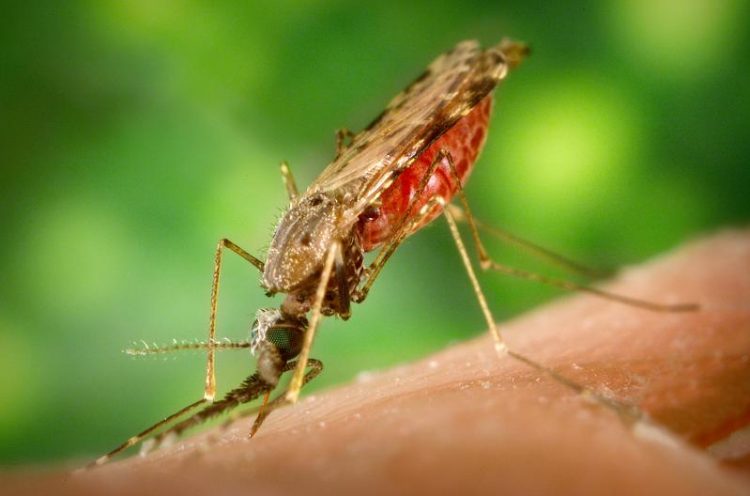The malaria pathogen’s cellular skeleton under a super-microscope

The Anopheles mosquito transmits the Plasmodium parasite, which causes malaria. CDC/James Gathany
The tropical disease malaria is caused by the Plasmodium parasite. For its survival and propagation, Plasmodium requires a protein called actin. Scientists of the Helmholtz Centre for Infection Research (HZI) in Germany used high-resolution structural biology methods to investigate the different versions of this protein in the parasite in high detail.
Their results, published in the scientific journal “PLOS Pathogens”, may in the future contribute to the development of tailor-made drugs against malaria–a disease, that causes more than half a million deaths per year.
Malaria is a life-threatening disease. According to World Health Organization estimates, around 207 million cases of malaria occurred in 2012. Children in Africa are at an especially high risk, and there is no approved vaccination to date.
The disease is caused by Plasmodium parasites–single-celled parasites, which are transmitted by mosquitos. The pathogen enters the human body through a bite and induces typical symptoms like periodic fevers, nausea, and headaches.
To enter human cells and leave them again, the parasites need to be motile. To this end, they use a structural protein called actin. Actin is found in nearly all living organisms where it is one of the most abundant proteins. Inside cells, it assumes numerous tasks: It confers stability, allows cell division, and makes movement of single cells possible.
The dynamical behaviour needed for these processes is enabled by individual globular actin molecules assembling together to form thread-like structures called filaments. The malaria parasite possesses two versions of actin, actin I and actin II, which differ substantially from each other. Even though these structural proteins are crucial for the pathogen’s infectivity, researchers have so far not been able to demonstrate filament formation in the parasite.
Scientists of the HZI, the German Electron Synchrotron (DESY) and the European Molecular Biology Laboratory (EMBL), together with international partners, now succeeded in detecting filament assembly of the parasite actin II proteins. For this, they used electron microscopy, which overcomes the resolution limit of classical light microscopy.
Male malaria parasites from which the scientists had deleted actin II were not able to form mature germ cells and consequently could not reproduce and propagate. To have only one actin variant is apparently not sufficient for this process. How filaments contribute to germ cell maturation is still unclear. But why do the two proteins show such different behaviour?
To answer this question, the research team deciphered the structure of the globular actin proteins using X-radiation. “We were able to determine the structures of actin I and actin II at very high resolutions–down to 1.3 and 2.2 Ångström, respectively. With this, we are in the range of single atoms,” says the project leader Prof Inari Kursula.
“The structures show us that the two variants differ more from each other than actins in any other known living organism do.” The high resolution enabled the researchers to identify areas within the proteins that cause the different behaviour. “We now understand that Plasmodium actin filaments are very different from other actin filaments, like for example from those found in humans, and that they are assembled in a very different manner. Now that we know the structural basis for this, we can look for ways to specifically interfere with the parasite cytoskeleton,” says Kursula. This knowledge might in the future contribute to designing tailor-made anti-malarial medication.
Original publication
Juha Vahokoski, Saligram Prabhakar Bhargav, Ambroise Desfosses, Maria Andreadaki, Esa-Pekka Kumpula, Silvia Muñico Martinez, Alexander Ignatev, Simone Lepper, Friedrich Frischknecht, Inga Sidén-Kiamos, Carsten Sachse, and Inari Kursula
Structural Differences Explain Diverse Functions of Plasmodium Actins
PLOS Pathogens, 2014, http://dx.plos.org/10.1371/journal.ppat.1004091
The junior research group “Structural Biology of the Cytoskeleton” at the interdisciplinary Centre for Structural Systems Biology (CSSB) investigates the cytoskeleton– a flexible network of proteins, which plays an important role in the motility and host cell entry of many pathogens. The scientists are especially interested in how Plasmodium, the malaria pathogen, uses its cytoskeleton for this purpose.
The Helmholtz Centre for Infection Research (HZI)
Scientists at the Helmholtz Centre for Infection Research in Braunschweig, Germany, are engaged in the study of different mechanisms of infection and of the body’s response to infection. Helping to improve the scientific community’s understanding of a given bacterium’s or virus’ pathogenicity is key to developing effective new treatments and vaccines.
http://www.helmholtz-hzi.de
http://www.helmholtz-hzi.de/en/news_events/news/view/article/complete/das_zellsk… – This press release on www.helmholtz-hzi.de
Media Contact
All latest news from the category: Life Sciences and Chemistry
Articles and reports from the Life Sciences and chemistry area deal with applied and basic research into modern biology, chemistry and human medicine.
Valuable information can be found on a range of life sciences fields including bacteriology, biochemistry, bionics, bioinformatics, biophysics, biotechnology, genetics, geobotany, human biology, marine biology, microbiology, molecular biology, cellular biology, zoology, bioinorganic chemistry, microchemistry and environmental chemistry.
Newest articles

First-of-its-kind study uses remote sensing to monitor plastic debris in rivers and lakes
Remote sensing creates a cost-effective solution to monitoring plastic pollution. A first-of-its-kind study from researchers at the University of Minnesota Twin Cities shows how remote sensing can help monitor and…

Laser-based artificial neuron mimics nerve cell functions at lightning speed
With a processing speed a billion times faster than nature, chip-based laser neuron could help advance AI tasks such as pattern recognition and sequence prediction. Researchers have developed a laser-based…

Optimising the processing of plastic waste
Just one look in the yellow bin reveals a colourful jumble of different types of plastic. However, the purer and more uniform plastic waste is, the easier it is to…



